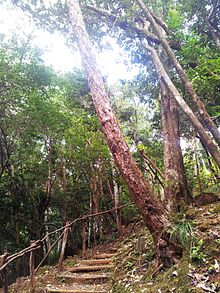bio.wikisort.org - Plant
Psiloxylon mauritianum (known locally as "bois bigaignon") is a species of flowering plant, the sole species of the genus Psiloxylon. It is endemic to the Mascarene Islands (Mauritius and Réunion) in the Indian Ocean.[1]
This article may be expanded with text translated from the corresponding article in French. (March 2021) Click [show] for important translation instructions.
|
| Psiloxylon | |
|---|---|
 | |
| Psiloxylon mauritianum tree growing in Vallée de Ferney reserve, Mauritius. | |
| Scientific classification | |
| Kingdom: | Plantae |
| Clade: | Tracheophytes |
| Clade: | Angiosperms |
| Clade: | Eudicots |
| Clade: | Rosids |
| Order: | Myrtales |
| Family: | Myrtaceae |
| Subfamily: | Psiloxyloideae |
| Tribe: | Psiloxyleae |
| Genus: | Psiloxylon Thouars ex Tul. |
| Species: | P. mauritianum |
| Binomial name | |
| Psiloxylon mauritianum (Bouton ex Hook.f.) Baill. | |
| Synonyms | |
|
Fropiera mauritiana Bouton ex Hook. f. | |
It is a white-barked evergreen tree, bearing essential oils. It is dioecious,[1] with male and female flowers on separate individuals. It is traditionally used as a medicinal plant, and appears contain compounds that inhibit the growth of Staphylococcus aureus.[1]
It was formerly placed alone in family Psiloxylaceae, but is now considered a basal member of the family Myrtaceae.[2]
References
- Sorres, Jonathan; André, Amandine; Elslande, Elsa Van; Stien, Didier; Eparvier, Véronique (2020). "Potent and Non-Cytotoxic Antibacterial Compounds Against Methicillin-Resistant Staphylococcus aureus Isolated from Psiloxylon mauritianum, A Medicinal Plant from Reunion Island". Molecules. 25 (16): 3565. doi:10.3390/molecules25163565. S2CID 221076087.
- P. G. Wilson; M. M. O'Brien; M. M. Heslewood; C. J. Quinn (2004). "Relationships within Myrtaceae sensu lato based on a matK phylogeny". Plant Systematics and Evolution. 251: 3–19. doi:10.1007/s00606-004-0162-y. S2CID 23470845.
 Media related to Psiloxylon mauritianum at Wikimedia Commons
Media related to Psiloxylon mauritianum at Wikimedia Commons Data related to Psiloxylon at Wikispecies
Data related to Psiloxylon at Wikispecies
На других языках
- [en] Psiloxylon
[es] Psiloxylon
Psiloxylon mauritianum es una especie de plantas con flores, es la única especie de la familia obsoleta, Psiloxylaceae, ahora, según el sistema APG II[1] convertida en la tribu Psiloxyleae perteneciente a la familia de las mirtáceas. Es endémico de las Islas Mascareñas (Mauricio y Reunión) en el Océano Índico.[ru] Псилоксилон
Псилоксилон (лат. Psiloxylon) — род цветковых растений в составе семейства Миртовые (Myrtaceae). Единственный представитель рода — вид Псилоксилон маврикийский (Psiloxylon mauritianum Baill.) — является эндемиком Маскаренских островов.Текст в блоке "Читать" взят с сайта "Википедия" и доступен по лицензии Creative Commons Attribution-ShareAlike; в отдельных случаях могут действовать дополнительные условия.
Другой контент может иметь иную лицензию. Перед использованием материалов сайта WikiSort.org внимательно изучите правила лицензирования конкретных элементов наполнения сайта.
Другой контент может иметь иную лицензию. Перед использованием материалов сайта WikiSort.org внимательно изучите правила лицензирования конкретных элементов наполнения сайта.
2019-2025
WikiSort.org - проект по пересортировке и дополнению контента Википедии
WikiSort.org - проект по пересортировке и дополнению контента Википедии